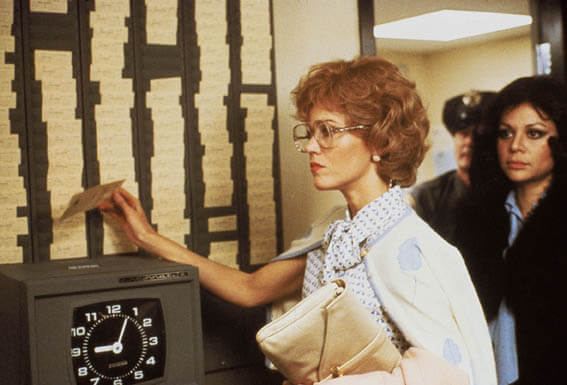Women are working harder and clocking more hours than ever before, with little-to-no paid family or sick leave, or job security. And it can only get worse, unless we make one crucial demand.
This article was made possible because of the generous support of DAME members. We urgently need your help to keep publishing. Will you contribute just $5 a month to support our journalism?
Once upon a time, not so very long ago, in this very country, there was a sustained movement that said that what working people needed most was less work.
The eight-hour-day movement, which itself grew out of the ten-hour-day movement, was a central demand of the labor movement in its pre–New Deal phase, before the National Labor Relations Act and Fair Labor Standards Act locked in a system that many of us would recognize even if we don’t work under its actual conditions. The five-day work week, the eight-hour day—the “nine to five” (thanks, Dolly Parton).
That eight-hour-day movement was calling for shorter hours with no reduction in pay; “eight hours for work, eight hours for sleep, eight hours for what we will” was its rallying cry. For this, workers struck, marched, and even died. It was perhaps the labor movement’s last unifying demand, one that could bring together workers across industries and race and gender lines. Women workers, especially, embraced the demand.
We are, it has been widely pointed out, in a post-New Deal working world. Union density is way down, along with wages; employer-provided health insurance and other benefits are fading. Erratic schedules, part-time jobs, and few protections are the norm for more and more people each year. Women now comprise nearly half the workforce and two-thirds of the low-wage workforce. We are the ones on whose backs the economy is changing.
Perhaps it’s not surprising then, that the demands around which working people and labor organizers are beginning to coalesce are commonly associated with women. Family leave got a boost from President Obama’s State of the Union speech, in which he called on Congress to pass a law that would require paid time off for workers who’ve recently had a baby. Laws mandating that employers provide at least a few paid sick days for their employees have appeared around the country, passed through state and city legislatures or via ballot initiatives at election time. Since the majority of family responsibilities still fall on women’s shoulders, women primarily benefit from these policies.
Without a national family leave program, as Rebecca Traister pointed out in a widely read piece in the New Republic, new mothers are trapped. The Clinton-era Family and Medical Leave Act, the single piece of national legislation granting rights to pregnant workers, only mandates 12 weeks of unpaid leave for workers at private companies with more than 50 employees, public agencies, or schools, and then only if they’ve been employed there for a year. Traister notes that this policy traps women in jobs for long periods of time—if you might possibly get pregnant, you need to stay in a position that will give you leave even if it doesn’t pay well, even if your boss is abusive, even if that job you’ve been eyeing across town has just opened up. And then, what if you have a difficult pregnancy that leaves you sick, unable to complete your duties? Nobody wants a waiter with morning sickness.
When unpaid leave is all that’s mandated, it is almost a guarantee that women, not men, will be the ones to take it—not only is it their bodies doing the physical work of childbearing (as Katha Pollitt writes, there’s a reason they call it labor) but they tend to make less money and therefore have the paycheck that can be given up. But this means that it’s their career that suffers. Unpaid leave strengthens gender inequality.
And what of the vaunted “flexibility” policies that we hear about lately? As Rebecca J. Rosen pointed out in the Atlantic, in practice, workers who get the benefit of being able to do their job from home sometimes often wind up working harder and longer to demonstrate that they’re not slacking. And if women are still the ones expected to do the housework, that means that flexible work policies may actually be creating still more work for women: the work they’re doing at home that necessitates the flexibility in the first place, and the extra work to ensure their boss continues to offer them the option.
At a time when, despite recent cheerleading for job-creation numbers, unemployment is still high—particularly for Black workers—and it looks increasingly likely new technologies will render more jobs obsolete, it’s ridiculous that we’re still finding new ways to work even longer hours. As Janet Gornick, professor of political science and sociology at the Graduate Center of the City University of New York, told me last year, shortening the work day would help move us toward gender equality, freeing everyone up both to share in the work at home, and de-stigmatizing the idea of taking time off for family commitments. Just providing better, higher-paid, part-time jobs with stable schedules would be a start, but while social norms still assume men work and women parent, those part-time jobs will still be assumed to be a thing for women.
The fight for paid family leave—for all parents, not just pregnant women—and for paid sick leave are deeply important, as is the fight for higher minimum wages (which once again would disproportionately impact women, who are clustered in low-wage fields). But I’d like to see labor revive the old demands for shorter hours, for less work, as well. If we understand work not as the source of all fulfillment or status, but as only a part of what we do to construct our lives, we can shake up gendered norms as well as other forms of stratification that have so many of us feeling trapped.
Sarah Jaffe is this week’s guest columnist for “All the Rage.”
